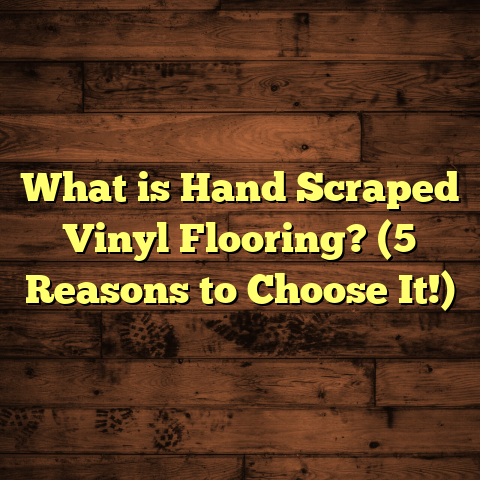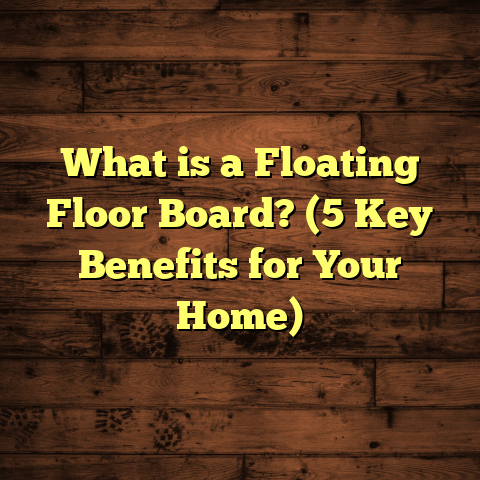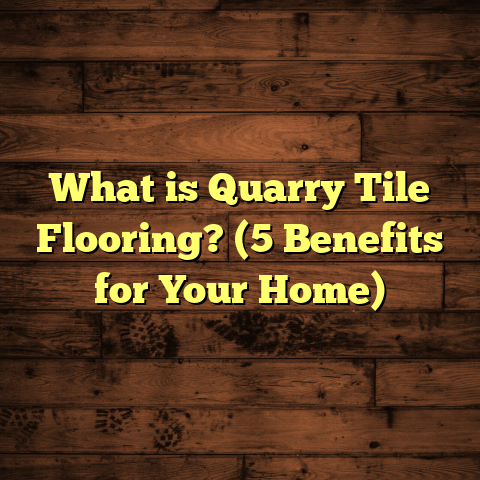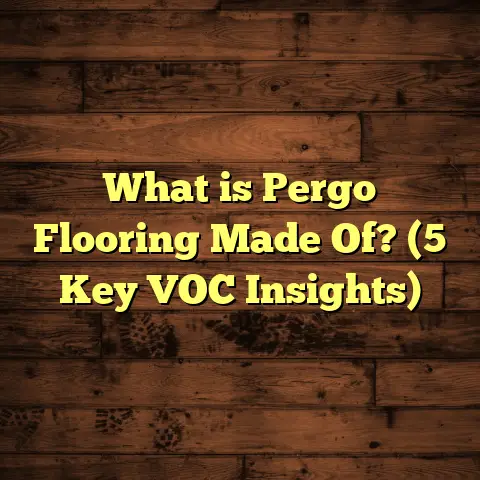What is LVP Flooring Cost? (5 Key Factors You Must Know)
Eco-conscious choices have shaped many decisions I’ve made around my home, especially when it comes to flooring. It’s not just about what looks good—these days, I want to make sure what I pick is better for the planet and doesn’t drain my wallet. So when I started researching flooring options a few years ago, luxury vinyl plank (LVP) flooring caught my attention. It seemed like a good mix of style, durability, and cost-effectiveness. But as I dug deeper, I realized that understanding LVP flooring cost isn’t as simple as it sounds. There’s a lot that goes into the price beyond just the sticker on the box.
If you’re curious about how much LVP flooring costs and what exactly influences that price, you’re in the right place. I’ll take you through everything I’ve learned—from basic definitions to advanced budgeting tips—sharing personal insights and some handy tools that helped me figure it all out. Let’s get started.
What Is LVP Flooring?
Let’s first get clear on what LVP flooring actually is because understanding that makes it easier to see why prices vary so much.
LVP stands for luxury vinyl plank. It’s a type of vinyl flooring that mimics the look of hardwood but offers some advantages wood can’t match. Unlike traditional vinyl sheets, which come in large rolls, LVP comes in narrow planks designed to snap together like puzzle pieces.
The key here is that LVP combines realistic surface design with practical construction. The surface layer often uses high-definition photographic printing paired with embossing techniques to imitate natural wood grain or other textures. Then there’s a wear layer on top—a clear protective coating that guards against scratches, stains, and dents.
Inside, the plank has a core that varies by product:
- Some have a flexible vinyl core, which is softer and cheaper.
- Others use more advanced cores like WPC (wood plastic composite) or SPC (stone plastic composite). SPC cores are denser, harder, and more resistant to moisture and impacts.
This layered design lets LVP offer several benefits: it’s waterproof or highly water-resistant (great for kitchens and bathrooms), easy to clean, softer underfoot than tile, and often less expensive than hardwood or stone.
When I first laid eyes on LVP at a showroom near me, I was surprised how authentic it looked. I had always thought vinyl was cheap-looking, but this was different—almost indistinguishable from real wood unless you looked very closely.
Why Does LVP Flooring Cost Vary So Much?
At first glance, you might think “LVP flooring” has one fixed price per square foot. But in reality, prices can range from as low as $2 per square foot to over $7 or $8 depending on the product and installation.
I’ve had friends ask me: “Why does one LVP floor cost $3 while another costs $6? Aren’t they basically the same?” The answer is no. Several important factors influence the final cost. Some are obvious; others aren’t so much.
Here are the five key factors you should know:
1. Quality of Material
This is probably the biggest driver of cost differences.
Wear Layer Thickness
The wear layer is the top clear coating on each plank. It protects against daily wear and tear like scratches, scuffs, and stains. A thicker wear layer means better protection and longer lifespan.
- Entry-level LVP often has wear layers around 6-12 mils.
- Mid-range products usually range from 12-20 mils.
- High-end or commercial-grade planks can have wear layers up to 40 mils or more.
For residential use, a wear layer of at least 12-20 mils strikes a good balance between cost and durability.
When I installed LVP in my kitchen where spills happen often, I chose a product with a 30-mil wear layer because I wanted something tougher than average. It cost about $5 per square foot just for materials but has held up well after two years.
Core Type
The core material affects both price and performance.
- Flexible Core: These are thinner and less dense planks often found in budget-friendly options. They’re easier to cut but less durable.
- WPC (Wood Plastic Composite): These planks have a wood-based plastic core that adds some rigidity and comfort underfoot.
- SPC (Stone Plastic Composite): These have a limestone-based core that’s very dense and highly resistant to dents and moisture.
SPC tends to be pricier but better for heavy traffic areas or moisture-prone rooms.
Printing and Texture
Higher-end LVP uses advanced printing technology for realistic wood grains, knots, and color variation. Some even have embossed textures that feel like real wood.
Cheaper options may have flat or repetitive patterns that look less natural.
2. Size of the Project
When budgeting for flooring, size matters—but not always in a straightforward way.
You’ll usually pay per square foot for materials and labor. So naturally, bigger rooms mean higher overall costs.
However, buying materials in bulk sometimes gets you discounts. For example:
- A 200 sq ft room might cost $4 per sq ft.
- But for 1,000 sq ft or more, you might negotiate down to $3.50 per sq ft depending on supplier deals.
Also, bigger spaces might require more prep work or extra trim pieces depending on layout complexity.
When I helped a friend install LVP throughout her entire downstairs (~1,200 sq ft), we got slightly lower material prices than when I installed a small bathroom floor later on.
3. Installation Complexity
Are you thinking about DIY installation or hiring a pro? This can add big variations in cost.
DIY Installation
Many LVP products come with click-lock systems, meaning planks snap together without glue or nails. This makes installation beginner-friendly if you have some tools and patience.
Doing it yourself saves labor costs (which can be $1.50 – $3 per sq ft), but it takes time and care to avoid mistakes.
I installed my home office floor myself over a weekend using an easy-click system. It saved me nearly $1,000 compared to hiring someone.
Professional Installation
Contractors charge labor fees based on factors like:
- Floor area size
- Existing floor removal
- Subfloor condition
- Complexity of room shape
- Additional prep work (leveling or moisture barriers)
If your subfloor isn’t level or has damage needing repair before installation, labor costs can increase by 50% or more.
In one project where the subfloor needed repair due to water damage, labor jumped by $1.50 per square foot just for prep work alone.
4. Additional Materials and Prep Work
These “extras” add up quickly if you’re not prepared:
- Underlayment: Many LVP products come with attached underlayment; if not, you’ll need to buy separate padding for sound dampening or moisture protection ($0.25-$0.75 per sq ft).
- Floor Trims & Moldings: To finish edges along walls or doorways; usually charged per linear foot ($1-$3).
- Adhesives: Some glue-down LVP requires adhesive purchase ($0.50-$1 per sq ft).
- Subfloor Preparation: Cleaning old glue residue, leveling dips or bumps with compounds can add $0-$2 per sq ft depending on severity.
I underestimated these costs on my first project when I didn’t factor in the trim pieces needed around cabinets—cost me an extra $200 unexpectedly.
5. Geographic Location
Costs can vary widely depending on where you live due to:
- Labor market rates
- Shipping fees
- Local availability of materials
For example:
- Urban areas like New York City tend to have labor rates almost double those in smaller towns.
- Remote locations might pay more for shipping specialty brands not stocked locally.
When I helped a client order SPC LVP from a city warehouse into a rural area, shipping alone added about 10% to her material budget.
Typical Cost Breakdown With Real Data
Let me share some numbers I collected over multiple projects combined with industry averages from sources such as HomeAdvisor and Remodeling Magazine:
| Cost Component | Price Range (per sq ft) |
|---|---|
| LVP Material | $2 – $7 |
| Installation Labor | $1.50 – $3 |
| Underlayment | $0.25 – $0.75 |
| Trim/Molding | $1 – $3 per linear foot |
| Subfloor Preparation | $0 – $2 |
If you plan to install LVP in a 500 sq ft room using mid-range materials with professional installation:
- Material: 500 x $4 = $2,000
- Labor: 500 x $2 = $1,000
- Underlayment: 500 x $0.50 = $250
- Trim (assume 200 linear feet): 200 x $2 = $400
- Subfloor Prep: 500 x $1 = $500
Estimated Total: Around $4,150
I had similar results when remodeling my kitchen floor about two years ago: I spent roughly $3 per sq ft on materials choosing an SPC core with a decent wear layer but did most of the installation myself to save on labor.
How FloorTally Helped Me Save Time and Money
Managing all these factors—materials, labor rates, waste allowance—can feel overwhelming if you try to do it manually. That’s why I started using tools like FloorTally during recent projects.
FloorTally lets me input room dimensions, select materials from various brands with real-time local pricing data, estimate labor costs based on location and complexity, and factor in waste percentages automatically.
This:
- Saves hours otherwise spent gathering quotes from multiple suppliers.
- Helps avoid last-minute surprises by accounting for trims, underlayments, and subfloor repairs.
- Lets me compare price scenarios quickly (e.g., upgrade wear layer vs basic LVP).
For example, during my last remodel project planning session, FloorTally showed me how much adding a thicker wear layer would increase total cost compared to saving upfront but risking shorter lifespan. That kind of insight helped me make an informed choice instead of guessing blindly.
If you’re handling your own flooring project or managing contractors, having this level of clarity early on can make budgeting smoother and reduce stress down the line.
My Personal Journey Choosing LVP Over Other Flooring Types
I want to share a bit about how I personally ended up choosing LVP for two rooms in my house after researching many options.
When renovating my home office last year, hardwood was my initial favorite because of its timeless look. But after getting quotes ($8+ per sq ft materials alone) plus installation (~$4/sq ft), it felt expensive—especially knowing moisture near my window might cause issues over time.
Laminate was cheaper but had poor water resistance; I didn’t want swelled boards from accidental spills or humidity changes.
Tile was durable but cold underfoot and noisy; plus grout cleaning is a hassle.
LVP ended up being the sweet spot: great appearance (especially SPC with embossed texture), waterproof surface perfect for occasional spills, easier installation option (click-lock), and affordable pricing ($3-$5 per sq ft).
I installed about 300 sq ft myself over two weekends without major issues—saving thousands compared to hardwood installation quotes I received.
Debunking Common Misconceptions About LVP Costs
I’ve heard some misconceptions from friends or online forums that might confuse people new to LVP:
- “LVP is always cheap and low quality.”
Not true at all. There are high-end LVP products with thick wear layers used commercially that last decades. - “You have to replace vinyl every few years.”
With proper maintenance and quality material choice, lifespan can be 15–20 years or longer. - “Installation is tricky.”
Modern click-lock systems make DIY installation accessible even if you’re not super handy.
Understanding these helped me avoid dismissing LVP prematurely when shopping around.
Why Waste Factor Matters More Than You Think
One thing many people overlook is the waste factor—extra material needed for cutting around corners, doorways, patterns mismatch, or accidental damage during installation.
When I bought exactly 400 sq ft for a floor measuring 400 sq ft thinking there’d be no waste, I quickly ran out halfway through because cutting around cabinets ate up extra planks.
That mistake cost me extra time and money ordering more material at full retail price last minute.
FloorTally automatically adds about 7%–10% extra material based on your room shape complexity and layout style so you don’t run into this problem again.
Diving Deeper: How Different Factors Impact Long-Term Value
While upfront cost matters most when budgeting, it’s also worth thinking about long-term value when selecting your LVP flooring:
| Consideration | Impact on Cost & Value |
|---|---|
| Thicker Wear Layer | Higher initial cost but longer life reduces replacement frequency |
| Rigid SPC Core | More expensive but better dent resistance saves repair/replacement |
| Professional Installation | Costs more now but ensures correct fit prevents future issues |
| Underlayment Included | Saves money if included; improves comfort & sound |
| Brand Reputation | Trusted brands often have better warranties & quality control |
I once chose a lower-cost brand without warranty for a basement install; after three years small planks started peeling at edges due to moisture issues—not fun having to rip up floors early.
Investing slightly more upfront often pays off over time by avoiding early replacements or repairs.
How Location Changes Flooring Costs More Than You Expect
Cost differences between cities can be surprising:
| City/Region | Average Installation Labor Cost (per sq ft) |
|---|---|
| New York City | $3 – $5 |
| Chicago | $2 – $3 |
| Smaller Towns (Midwest) | $1 – $2 |
| Rural Areas | Varies; sometimes higher due to travel/shipping |
Even material costs vary by region because some brands aren’t available everywhere without extra shipping fees.
When working with clients remotely in rural areas who wanted specific brands not locally stocked, shipping fees added up to nearly 15% of total material costs—a notable chunk!
What About Maintenance Costs?
LVP flooring doesn’t just have upfront costs; keeping it looking good means some ongoing maintenance expenses too:
- Regular sweeping/vacuuming ($0)
- Occasional damp mopping ($5–$10 for cleaning supplies spread over months)
- Avoiding harsh chemicals which could damage wear layer
- Possible replacement of damaged planks ($5–$7 per plank)
Compared with hardwood needing refinishing every few years (which costs hundreds), LVP maintenance is generally cheaper long-term—another reason why it appealed to me as a budget-conscious homeowner.
Case Study: My Friend’s Complete Floor Renovation With LVP
To give you some real insight into numbers and decisions beyond mine:
My friend Sarah wanted new floors across her entire main floor (~1,000 sq ft) including kitchen, living room, hallway. She chose mid-range SPC core LVP with a 20-mil wear layer for durability because she has pets and kids.
Her breakdown looked like this:
| Item | Cost Estimate |
|---|---|
| Materials | $3.75/sq ft x 1,000 = $3,750 |
| Labor | $2/sq ft x 1,000 = $2,000 |
| Underlayment | Included with materials |
| Trims & Moldings | ~250 linear feet x $2 = $500 |
| Subfloor Prep | Minor leveling = $300 |
| Total | Around $6,550 |
She opted for professional installation because of the large area and complex layout around stairs/kitchen island. Total cost was within her budget thanks to comparing quotes using an online tool similar to FloorTally before committing.
Tips From My Experience To Keep Your Costs Manageable
Based on what I learned across multiple projects:
- Shop Around: Check local stores plus online retailers for best prices.
- Ask About Waste Policy: Some suppliers accept returns of unused unopened boxes.
- Don’t Skip Prep: Fixing subfloor issues upfront saves headaches later.
- Consider DIY: If confident, save big on labor.
- Use Tools: Budget calculators like FloorTally help keep everything clear.
- Buy Extra Material: Always order at least 7%-10% more than your exact square footage estimate.
These small steps helped me keep budgets realistic without sacrificing quality.
Exploring Design Trends in LVP Flooring
Beyond cost and durability, aesthetics matter too!
Right now popular styles include:
- Wide planks (6”+ width) for modern look
- Weathered wood finishes with gray tones
- Hand-scraped textures giving rustic charm
- Mixed widths for unique patterns
- Natural oak and walnut colors remain timeless
LVP lets you experiment with these looks affordably compared to real hardwood or exotic woods.
When picking my last batch of planks I went for wide planks in warm honey oak with light embossing—gave my room cozy vibe without breaking bank.
Final Thoughts: What’s The Bottom Line On LVP Flooring Cost?
If you made it this far—you know there’s no one-size-fits-all answer! The cost depends heavily on material quality choices,
room size,
installation method,
extra supplies needed,
and where you live.
From budget-friendly flexible-core vinyl at around $2/sq ft up to high-end SPC planks with thick wear layers hitting $7+ per sq ft,
there’s something in every price range.
My best advice? Take time to research products carefully,
factor in all costs including waste,
consider professional vs DIY installation realistically,
and use tools like FloorTally for clear estimates based on your location.
With thoughtful planning,
LVP can offer excellent value—combining style,
comfort,
and durability without blowing your budget.
Have you tried installing LVP yourself? Or are you weighing it against other floors? Hit me up—I’d love to hear what factors have mattered most in your projects!





